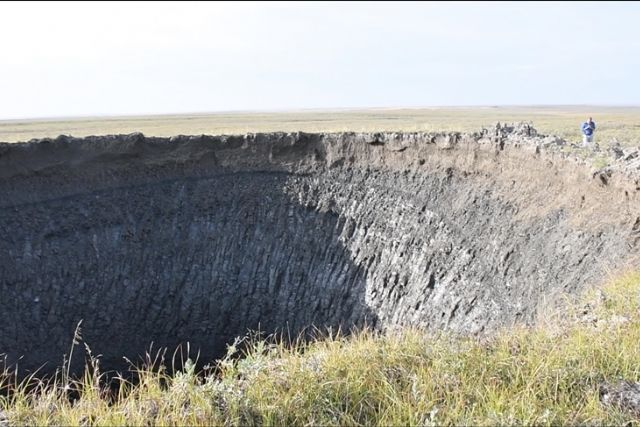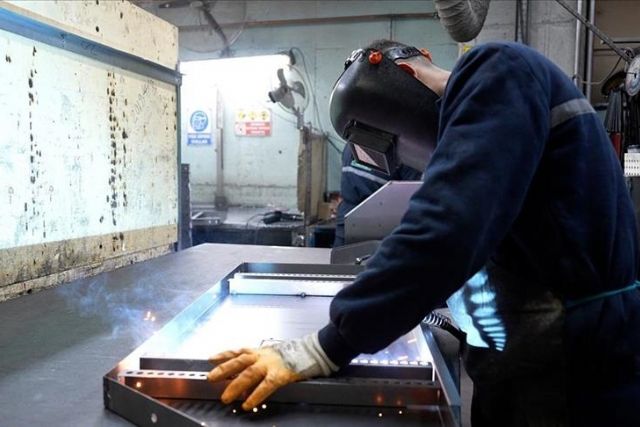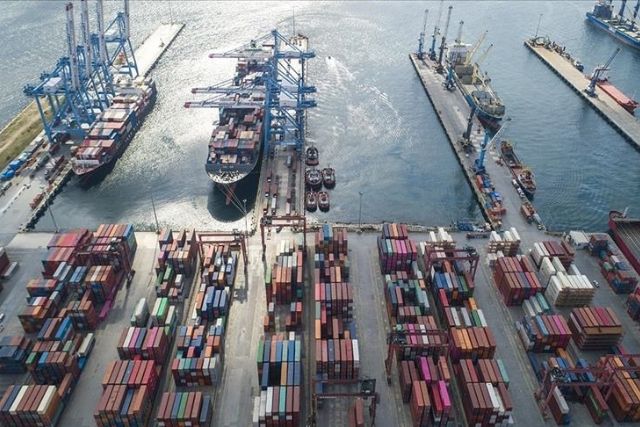Methane blowout craters in Siberia are ‘canary in a coal mine for global climate’
Permafrost contains more carbon than atmosphere and, when thawed and released, some of this carbon can further amplify climate warming, scientist warns

ISTANBUL
Gases released from methane craters on Siberia's Yamal and Gydan peninsulas as well as the immense amounts of carbon dioxide released from wildfires in the region can accelerate global warming, experts have warned.
The first known crater formed as a result of methane explosions was discovered in the summer of 2014 on Yamal, which holds what may be the world's largest natural gas reserves.
After studying the approximately 20 craters later registered there, in Russia's far north, experts said the methane explosions resulted from global warming.
Number of craters increased with global warming
“Massive layers of frozen rock that formed in northern Siberia tens of thousands of years ago are currently experiencing the impact of global warming that began in the 1970s,” Evgeny Chuvilin, a research scientist at Moscow's Skolkovo Institute of Science and Technology, a leading institution researching the craters, told Anadolu Agency.
The impact of global warming can be seen in rock formations in the region, he said.
“The delayed effects of climate warming manifest themselves through deeper seasonal thawing of rock and higher temperatures of upper permafrost horizons,” he added.
Chuvilin said that over the past 40-50 years, northwestern Siberia has witnessed an increase of nearly 3 degrees Celsius in average air temperatures, longer summers, heavier precipitation, and thicker snow cover.
Citing Russian researchers, he added that “the heat impulse produced by higher air temperatures reaches down to a depth of 25-30 meters (82-98 feet) of the permafrost layer in the Arctic tundra, while temperatures in the upper permafrost horizon, i.e. 10-15 meters (32-49 feet), have increased by an average of 0.3-1 degrees over the last 10 years.”
“Before a crater opens up, natural gas, mainly methane, builds up locally under pressure in the shallow permafrost horizons. A gas eruption and formation of a crater are preceded by surface swelling, which turns into a fast-growing pingo” or dome-shaped mound consisting of a layer of soil over a large core of ice occurring in permafrost areas, Chuvilin said, explaining the formation process of the craters in the Yamal and Gydan peninsulas.
“Direct gas release into the atmosphere is held back for some time by a blanket of frozen rock. The higher the pressure surge inside the gas-saturated zone, the more powerful is the blowout.”
New blowout craters to appear soon in Arctic tundra
Chuvilin said the gas blowout craters in the Arctic tundra of northwestern Siberia have formed more frequently over the last decades, although more of them might have appeared in the past.
“These recent occurrences coincided with the warming in the Arctic, including the warming of the upper permafrost horizons,” he noted.
“A gas cavity forming in the upper permafrost horizons before the crater opens up can have a volume of up to 1,000 cubic meters. Gas blowout from such a gas-saturated cavity can emit thousands and possibly tens of thousands of cubic meters of methane into the atmosphere,” Chuvilin warned.
Noting that around 20 blowout craters have been registered so far in the region, he said that “since climate warming is likely to linger at least for some time and, according to some forecasts, even pick up momentum, we should expect new blowout craters to appear soon in the Arctic tundra.”
‘Canary in a coal mine for global climate'
Scott Zolkos, a leading research scientist at the Woodwell Climate Research Center in the US state of Massachusetts, warned that the methane released from the craters could speed up climate change.
“The amount of greenhouse gas released from any individual crater represents a very small contribution to climate warming,” Zolkos said.
“The permafrost contains more carbon than is in the atmosphere and, when thawed and released, some of this carbon may end up in the atmosphere and further amplify climate warming.”
“So the craters are a canary in the coal mine for permafrost ecosystems and global climate,” he added.
Noting that there are no known engineering solutions that could be effectively scaled to prevent the release of greenhouse gases from methane craters into the atmosphere, Zolkos said “the most effective way to prevent greenhouse gas emissions from permafrost thaw is to stop the thaw, by eliminating the combustion of fossil fuels to halt climate warming.”
Craters are symptomatic of climate warming
Brendan Rogers, also a research scientist at Woodwell, said the craters are symptomatic of climate warming across the northern permafrost zone and there is a high possibility of more craters forming in the coming years.
Telling how wildfires are "known to burn off organic material from atop permafrost, which insulates and protects from thaw,” Rogers underlined that wildfires in the region can accelerate thaw, increase greenhouse gas emissions into the atmosphere, and thus exacerbate climate change.
“Whether induced and exacerbated by humans or extreme weather from climate change, thaw slumps and other forms of permafrost thaw show that humans are fundamentally changing ecosystems and diminishing critical ecosystem services,” he noted.
Months of wildfires
In 2021, wildfires in Siberia lasted for months and reached a point where they were larger than the rest of the wildfires worldwide in August, with smoke reaching the Arctic region for the first time.
This year wildfires in the region started on May 6 and are still continuing.
Doganay Tolunay, who researches forests and ecology at Istanbul University, said the blazes had other effects besides accelerating the permafrost thaw in the region.
He stressed that in hot summer months and severe droughts, peatland dries up and leaves in forests and tundra lose their moisture, becoming more flammable.
“The areas affected by the fires in Russia are mostly intact ecosystems,” Tolunay said.
“The extinguishing of these fires, generally called soil or peat fires, are impeded by the spread of fires to large areas and the smoldering of flammable materials accumulated on the ground.”
Telling how forests in northern latitudes grow very slowly due to the cold, Tolunay noted that these forests still have a massive amount of carbon stored.
“Thus,” he said, “the burning of forests in northern latitudes releases significant amounts of carbon dioxide into the atmosphere. Since forests in northern latitudes do not adapt to fires like the red pine forests do in Türkiye, it is very difficult to reforest after a fire.”





